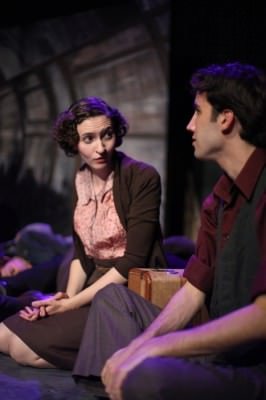The War Plays
Directed by Kate Nawrocki
Produced by The Strange Tree Group
At the Athenaeum Theatre, Chicago
The War Plays runs thin on accuracy
Playwright Emily Schwartz departs from the wacky and whimsical original concept plays she has successfully written over the last few years for a World War II reality piece set in London during The Blitz (6 September 1940 and 10 May 1941).
The press notes state:
It is the fall of 1940 and the Blitz has blasted a hole in the hearts of Londoners, while somewhere across the sea a young couple dances knowing that each passing moment could be their last. Old loves are rekindled, new loves are destroyed, the lighting grid is at your feet and the Germans are at the door. We must all keep calm and carry on together as we take shelter for the show alongside a troupe of displaced actors and musicians who are set to perform their parts as the boxy walls of the Athenaeum crumble at their feet.
Upon arrival at the Athenaeum theatre’s main floor studio, you are invited into the venue’s old bar area where you’ll hear a small Salvation Army-type band and singer performing classic swing tunes. This hooky group featured several singers who couldn’t hardly be understood. After several out-0f-tune songs, the announcer schooled us with the air raid warnings’ do’s and don’ts. I’m assuming we are in the USA?
We are next asked to move into the studio theatre where again the band continues to butcher 30/40’s swing standards. This cute parody of wartime bands adds flavor to the show.
When the first of the three short plays begins, we are in a subway tunnels hovered together with a group ducking the Nazi bombing of London, circa 1940. We meet Ruby Walters (Delia Baseman) and her brother, both Americans living in London with their father, a U.S. government official. A idealistic British teen, Skip Wilkes (Marty Scanlon) strikes up a conversation with ruby that quickly turns into a teen puppy-love encounter. This cute little play begs for a dialect coach, as does the third play, since Scanlon and the players in the third play have little effect doing a British accent. Only after much dialogue, Scanlon use British verbiage but never an authentic accent.
The second play finds a young soldier, Lee Farley (Patrick Cannon) wanting to ‘rent’ a girl for his last dance before shipping out. My problem here is that in 1940, the United States was not at war and the draft didn’t start until 1941 so the soldier wasn’t shipping out oversees until at least 1942. So, the mood of this play just didn’t work for me.
Lastly, the third play has two men and a girl in a location that must have been in the English countryside, I think? Devoid of any British accents and having one of the men wearing a green dress jacket from the Viet Nam Era U.S. Army, it wasn’t clear where and who these two men are from and what war they are speaking about. Since there was a reference to a dead brother sending a telegram from war-torn France, it was probably War War II.
All three stories had their moments of nostalgia and cuteness but the devil is in the details and these were lacking. If your going to do an era specific play, please use accurate accents, places, uniforms, etc. The only accurate item was the dresses and hair styles of the women.
The all around experience of this cute, somewhat entertaining piece makes for a mildly worthy night at the theatre. Younger theatre patrons will not be so bothered with the details as I am.The Strange Tree Group usually produces stronger plays, so we’ll forgive them this one.
Somewhat Recommended
Tom Williams
At the Atehnaeum theatre, 2936 N. Southport, Chicago, IL, www.strangetree.org, tickets $25, $15 Thursday industry, Thursdays thur Saturdays at 8 pm, Saturdays at 3 pm, Sundays at 5pm, running time is 80 minutes without intermission.




